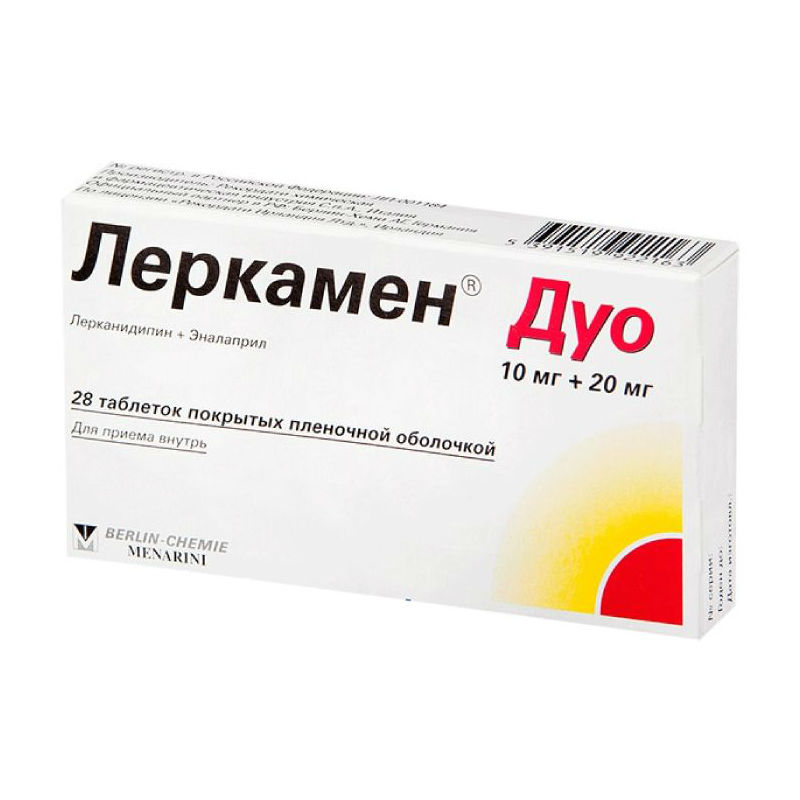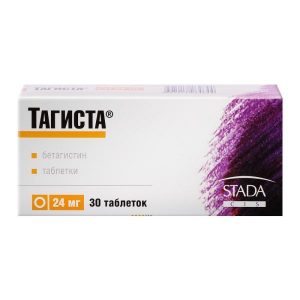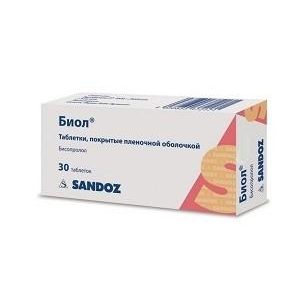Description
Pharmacological action of
The drug is a combination of an ACE inhibitor and a slow calcium channel blocker.
Lercanidipine
Lercanidipine, a derivative of the dihydropyridine series, inhibits the transmembrane flow of calcium into cardiac and smooth muscle cells. The mechanism of antihypertensive action is due to the direct relaxing effect on the smooth muscles of blood vessels, resulting in a decrease in OPSS. It has a prolonged antihypertensive effect. Due to its high selectivity to vascular smooth muscle cells, there is no negative inotropic effect.
Enalapril
Enalapril is an ACE inhibitor that inhibits the formation of angiotensin II and eliminates its vasoconstrictor effect. Lowers blood pressure without causing an increase in heart rate and minute volume. Reduces OPSS, reduces afterload and preload on the heart. Reduces pressure in the right atrium and pulmonary circulation.
Does not affect the metabolism of glucose, lipoproteins, as well as the function of the reproductive system.
Pharmacokinetics
Pharmacokinetic interaction with the simultaneous use of enalapril and lercanidipine was not observed.
Lercanidipine
Absorption
Lercanidipine is completely absorbed in the gastrointestinal tract after oral administration. At the first passage through the liver, due to high metabolism, the absolute bioavailability when taken orally after a meal is approximately 10% when taken on an empty stomach, the bioavailability decreases by 1/3. The bioavailability after the use of lercanidipine increases 4 times if the drug is taken no later than 2 hours after ingestion of fatty foods. Therefore, the drug should be taken at least 15 minutes before a meal. Cmax in blood plasma is reached after 1.5-3 hours. Does not cumulate with repeated use.
The duration of the therapeutic effect of lercanidipine is 24 hours. The concentration of lercanidipine in blood plasma when administered orally is in a non-linear dose-dependent manner. When taking 10 mg, 20 mg or 40 mg Cmax of lercanidipine in blood plasma was determined in a ratio of 1: 3: 8, respectively, and AUC in a ratio of 1: 4: 18, which suggests a progressive saturation during the first passage through the liver. Accordingly, bioavailability increases with increasing dose.
Distribution of
Distribution of lercanidipine from blood plasma to tissues and organs occurs quickly and intensively. The binding of lercanidipine to plasma proteins exceeds 98%.
Metabolism
Lercanidipine is metabolized by the liver isoenzyme CYP3A4 to form inactive metabolites.
Excretion
The drug in its unchanged form is practically not found in urine and feces. About 50% of the dose of lercanidipine taken is excreted by the kidneys, the average T1 / 2 of lercanidipine is 8-10 hours.
Pharmacokinetics in special clinical cases
In elderly patients and patients with mild or moderate renal failure or mild or moderate hepatic insufficiency, pharmacokinetic parameters of lercanidipine are the same as in the general group of patients.
In patients with severe renal failure or in patients on hemodialysis, lercanidipine is excreted by the kidneys in a higher amount (about 70%).
In patients with hepatic insufficiency (moderate to severe), the systemic bioavailability of lercanidipine is increased, because the drug is metabolized mainly in the liver.
In patients with renal and hepatic insufficiency, the plasma protein content is reduced, so the free fraction of lercanidipine can be increased.
enalapril
Absorption
Percentage of absorption of enalapril after oral administration is about 60%. Cmax of enalapril in blood plasma is observed after 1 hour. Eating does not affect the absorption of enalapril.
Distribution of
When ingested, it quickly hydrolyzes to enalaprilat, which has an inhibitory effect on ACE. Cmax enalaprilat in serum is observed 3-4 hours after taking the drug. The binding of enalapril to plasma proteins does not exceed 60%.
Metabolism
When ingested, it is hydrolyzed to the main metabolite – enalaprilat.
Excretion
About 40% of enalapril in the form of enalaprilat and about 20% of unchanged enalapril are excreted by the kidneys.
Pharmacokinetics in special clinical cases
In patients with renal failure, the duration of exposure to enalapril and enalaprilat is increased.
In patients with mild or moderate renal failure (CC 40-60 ml / min) when taking 5 mg of enalapril 1 time / day, the AUC plateau stage of enalaprilat is doubled compared with patients with normal liver function.
In patients with severe renal failure (CC> 30 ml / min), AUC increases by about 8 times. In this stage of renal failure, T1 / 2 enalaprilat increases with repeated use of enalapril maleate and the time to reach the AUC plateau stage slows down. Enalaprilat can be removed from the general bloodstream through hemodialysis. Dialysis clearance is 62 ml / min.
Indications
Essential hypertension (with monotherapy with lercanidipine 10 mg ineffective) – 10 mg + 10 mg dose
essential hypertension (with enalapril monotherapy inefficiency 20 mg) – 10 mg + 20 mg.
Contraindications
Disruption of outflow from the left ventricle, including aortic stenosis
chronic heart failure in the stage of decompensation
hereditary and / or idiopathic angioedema (including a history of) history of illness unstable angina pectoris
the first month after myocardial infarction (within 28 days)
severe renal failure (CC <30 ml / min), including patients on severe hemodialysis hepatic insufficiency simultaneous use with powerful inhibitors of the isoenzyme CYP3A4 (ketoconazole, itraconazole, erythromycin, ritonavir, troleandomycin), cyclosporine, grapefruit juice lactase deficiency, lactose intolerance, glucose / galactose malabsorption syndrome children and adolescents under the age of 18 hypersensitivity to lercanidipine, enalapril, or to any other ACE inhibitor and other BMID, as well as to other dihydrogen derivative. Caution sinus node weakness syndrome (without the simultaneous use of an artificial pacemaker) dysfunction of the left ventricle and coronary heart disease renal failure (CC more than 30 ml / min) renovascular hypertension condition after renal transplantation limited experience insufficiency inhibition of bone marrow hematopoiesis severe autoimmune diseases of the connective tissue (including scleroderma, systemic lupus erythematosus) concomitant use with immunosuppressants, allopurinol, procainamide diabetes mellitus surgical interventions and general anesthesia patients on a diet with restriction of sodium chloride hyperkalemia, such as, diarrhea, vomiting, primary aldosteronism. Special instructions Patients with severe arterial hypotension with systolic blood pressure less than 90 mm Hg, as well as patients with decompensated heart failure, require special attention in the treatment of hypertension. Transient arterial hypotension is not a contraindication to continued treatment, because after replenishment of the BCC, an adequate response to taking the drug can be expected. Particular care must be taken in the initial stages of treatment for patients with mild to moderate renal failure. Patients with bilateral renal artery stenosis or arterial stenosis of a single functioning kidney are particularly at risk of hypotension or renal failure due to ACE inhibitors. For this group of patients, treatment should be carried out under the strict supervision of a doctor, with careful selection of the dose and the appointment of low doses of the drug. Before starting and during treatment, it is necessary to monitor renal function. Special care should be taken in the initial stages of treatment of patients with mild to moderate severity of liver failure. In case of jaundice and a significant increase in the activity of liver enzymes, it is urgent to stop taking ACE inhibitors and consult a doctor. Due to the increased risk of anaphylactic reactions, the drug should not be prescribed to patients undergoing hemodialysis using high-strength polyacrylonitrile membranes (AN69) undergoing apheresis of low density lipoproteins with dextran sulfate and immediately before the desensitization procedure for aspen or bee venom. Like other ACE inhibitors, it has a less pronounced antihypertensive effect in patients of the Negroid race compared with representatives of other races. Due to the use of enalapril, angioedema of the face, limbs, tongue, pharynx or larynx may develop. In this case, you should immediately stop taking the drug. Angioedema of the larynx can be fatal. Angioedema of the tongue, pharynx or larynx can lead to airway obstruction, it is necessary to immediately inject 0.3-0.5 ml of a solution of epinephrine (adrenaline) s / c in a ratio of 1: 1000 and maintain airway patency (intubation or tracheostomy). Among patients of the Negroid race receiving therapy with an ACE inhibitor, the incidence of angioedema is higher than among patients of a different race. Patients with a history of angioedema not associated with the use of ACE inhibitors have an increased risk of developing angioedema with any ACE inhibitor. Before surgery (including dentistry), the surgeon / anesthetist should be advised of the use of ACE inhibitors. During surgical interventions and / or during general anesthesia using drugs, causing arterial hypotension, ACE inhibitors can block the formation of angiotensin II in response to compensatory release of renin. If a marked decrease in blood pressure develops, which is explained by a similar mechanism, it can be corrected by an increase in bcc. Hyperkalemia may develop during therapy with ACE inhibitors, including and enalapril. Risk factors for hyperkalemia are renal failure, old age, diabetes mellitus, some concomitant conditions (decreased BCC, acute heart failure at the stage of decompensation, metabolic acidosis), concomitant use of potassium-sparing diuretics (such as spironolactone, eplerenone, triamteren, amyloride), as well as drugs potassium or potassium-containing salt substitutes and the use of other drugs, contributing to an increase in potassium in the blood plasma (for example, heparin). Hyperkalemia can lead to serious cardiac arrhythmias, sometimes fatal. The combined use of the above drugs must be carried out with caution. It is not recommended to drink alcohol during the period of drug therapy. There is evidence of reversible biochemical changes in the sperm heads when calcium channel blockers are used, which may impair their fertility. Influence on the ability to drive vehicles and control mechanisms It should be borne in mind the possibility of weakness and drowsiness, therefore care must be taken when performing work requiring increased attention, especially at the beginning of treatment, with an increase in the dose of the drug and when driving vehicles. Composition 1 tab. contains: Active substances: lercanidipine hydrochloride 10 mg, enalapril maleate 20 mg. Excipients: lactose monohydrate – 92 mg, microcrystalline cellulose – 40 mg, carboxymethyl starch sodium – 20 mg, povidone K30 – 8 mg, sodium bicarbonate – 8 mg, 2 mg. Shell composition: opadry yellow (02F22330) – 6 mg (hypromellose 5cP – 3.825 mg, titanium dioxide (E171) – 1.139 mg, talc – 300 mcg, macrogol 6000 – 600 mcg, quinoline yellow dye (E104) – 121 mcg, yellow iron dye (E172) – 15 mcg). Dosage and administration of Tablets are taken orally, preferably in the morning, at least 15 minutes before meals, without chewing, drinking plenty of water. Do not drink grapefruit juice. Coripren ® is not intended for the initial treatment of hypertension. If monotherapy with lercanidipine 10 mg is ineffective, you should start taking Coripren ® 10 mg lercanidipine + 10 mg enalapril. If enalapril monotherapy is not effective, 20 mg, you should start taking Coripren ® 10 mg lercanidipine + 20 mg enalapril. The dose of the drug is selected by the doctor. Overdose There is no evidence of an overdose of the drug. Presumably, in case of an overdose, it can cause conditions caused by an overdose of any of the active substances. Lercanidipine Symptoms: peripheral vasodilation with a marked decrease in blood pressure and reflex tachycardia, vomiting. Treatment: symptomatic treatment, the choice of treatment depends on the degree of overdose and on the symptoms observed. The following methods of medical care are used: gastric lavage, taking high doses of catecholamines, furosemide, cardiac glycosides and plasma substitutes, activated charcoal, laxatives and iv dopamine. Also, to prevent the development of bradycardia, iv administration of atropine is possible. Enalapril Symptoms: the main symptom of an overdose is a pronounced decrease in blood pressure, which is accompanied by blockade of the renin-angiotensin-aldosterone system. Collapse, electrolyte imbalance, renal failure, hyperventilation, tachycardia, palpitations, bradycardia, dizziness, anxiety and cough may also develop. Treatment: symptomatic treatment. In severe cases, intravenous administration of a 0.9% sodium chloride solution and, if possible, infusion administration of angiotensin II and / or catecholamines is recommended. If overdose symptoms develop immediately after taking the drug, then it is necessary to induce vomiting, gastric lavage and take drugs from the group of adsorbing agents or sodium sulfate. Storage conditions The drug should be stored out of the reach of children at a temperature not exceeding 25 ° C. Expiration 2 years. Formulation tablets




